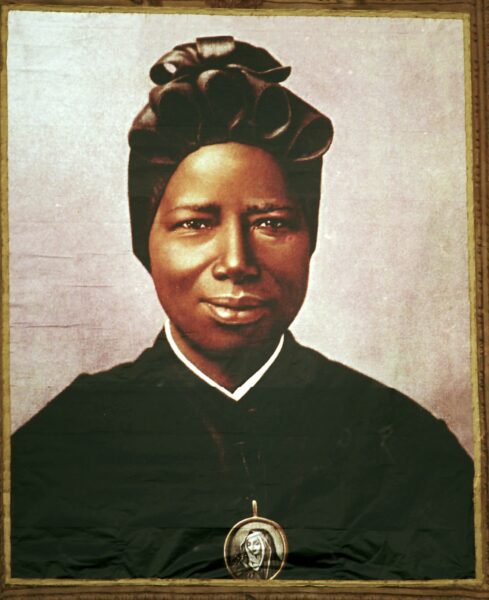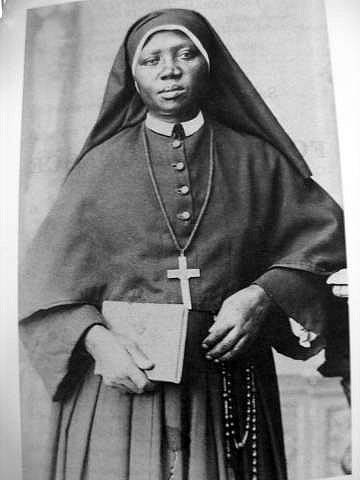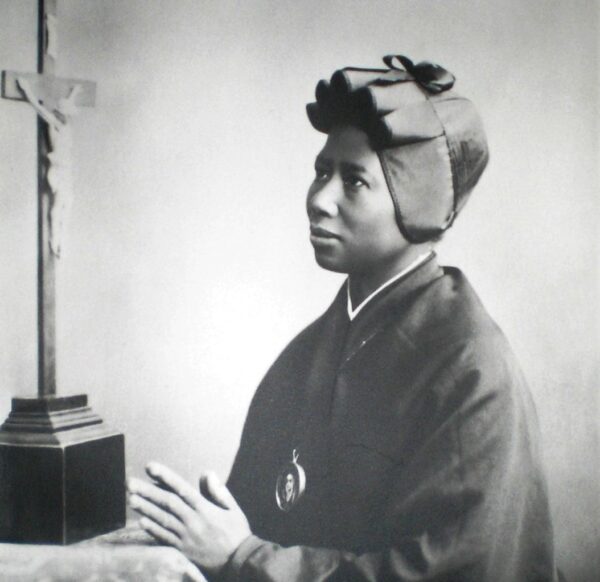 Last updated: February 5, 2024
Last updated: February 5, 2024
Josephine Bakhita (circa 1868-1947,) shown at left, was born into a relatively wealthy family in the village of Olgossa in the Darfur region, Sudan in central Africa. At around 7-9 years of age, she was kidnapped by Arab slave traders and was given the Arabic name bakhīta (بخيتة), which means “lucky” or “fortunate.” This was a fairly common name for slaves, and so Josephine Bakhita should not be confused with Sister Fortunata Quasce, the first Sudanese nun, also known as Bakhita Kwashe (1841-1899.) Apparently the image below and to the right is of Sister Fortunata Quasce and not Josephine Bakhita – see reference 6 for more information about Bakhita Kwashe.
Josephine Bhakita was sold and re-sold several times at the markets of El Obeid and Khartoum and was treated with great cruelty. Once she offended one of her owner’s sons, and he lashed and kicked her so severely that she was unable to move from her straw bed for over a month. Of her time with her fourth owner, Bakhita said, “During all the years I stayed in that house, I do not recall a day that passed without some wound or other. When a wound from the whip began to heal, other blows would pour down on me.”
 In 1883, Bakhita was bought by Callisto Legani, the Italian consul in Khartoum, Sudan, who treated her more kindly. Two years later, he took her to Italy and gave her to Augusto Michieli and his wife Turina. Bakhita lived with her new owners at their family villa at Zianigo, about 16 miles west of Venice and she became nanny to the couple’s daughter Mimmina, who was born in February 1886. Around that time, Michieli bought a large hotel in Suakin, the largest port city in Sudan, where he intended to move his family permanently. However, selling his property in Italy took longer than expected.
In 1883, Bakhita was bought by Callisto Legani, the Italian consul in Khartoum, Sudan, who treated her more kindly. Two years later, he took her to Italy and gave her to Augusto Michieli and his wife Turina. Bakhita lived with her new owners at their family villa at Zianigo, about 16 miles west of Venice and she became nanny to the couple’s daughter Mimmina, who was born in February 1886. Around that time, Michieli bought a large hotel in Suakin, the largest port city in Sudan, where he intended to move his family permanently. However, selling his property in Italy took longer than expected.
By the end of 1888, Turina Michieli wanted to see her husband in Sudan, even though the land transactions were not yet complete. Because the villa had been sold, she decided to leave Mimmina with Bakhita, who accompanied her to the Institute of the Catechumens in Venice, which was run by the Daughters of Charity of Canossa.
During this time, Bakhita became attracted to the Catholic Church and decided that she wanted to enter the convent. When the Michielis returned to take Mimmina and Bakhita back, she firmly asserted that she wanted to stay with the sisters. When Michieli pressed for a court case, the Patriarch of Venice and the Canossian sisters spoke up on her behalf. On 29 November 1889, an Italian judge ruled that, because the British had outlawed slavery in Sudan before Bakhita was born, and because slavery was illegal in Italy, technically she had never legally been a slave. She was baptized and confirmed in 1890, taking the name Josephine Margaret. In 1893, she entered the Institute of St. Magdalene of Canossa as a novice and then made her final vows in 1896.
In 1902, Josephine was assigned to to the city of Schio in the northern Italian province of Vicenza, where she assisted her religious community by cooking, sewing, and welcoming visitors. She was well loved by the children who attended the sisters’ school and by the local citizens as well. However, she also had a strong missionary drive. Between 1935 and 1939, she spent some extended time away, staying at the Missionary Novitiate in Milan and visiting other Canossian communities in Italy, talking about her experiences and helping to prepare young sisters for work in Africa.
Josephine was known for her comforting voice and gentle demeanor. In addition, she demonstrated an amazing amount of forgiveness and generousity with her statement, “If I were to meet those slave raiders who abducted me and those who tortured me, I’d kneel down to them to kiss their hands, because, if it had not been for them, I would not have become a Christian and religious woman.”
 Near the end of her life, Jospehine became sick with a delirium that caused her to relive the pain that she had experienced as a slave. She called out to the sisters who were taking care of her to “loosen the chains … they are heavy.” Nevertheless, she bore her pain cheerfully and it is said that, when asked how she was, that she would smile and simply reply, “as the Master desires.”
Near the end of her life, Jospehine became sick with a delirium that caused her to relive the pain that she had experienced as a slave. She called out to the sisters who were taking care of her to “loosen the chains … they are heavy.” Nevertheless, she bore her pain cheerfully and it is said that, when asked how she was, that she would smile and simply reply, “as the Master desires.”
Josephine Bakhita was beatified in 1992 and canonized in 2000. She became the first saint from Africa since the early centuries of Christianity. Pope John Paul II said, that in Mother Josephine, “we find a shining advocate of genuine emancipation. The history of her life inspires not passive acceptance but the firm resolve to work effectively to free girls and women from oppression and violence, and to return them to their dignity in the full exercise of their rights.” Today Josephine Bakhita is invoked as the patron saint of the enslaved, victims of human trafficking, and the country of Sudan. Her feast day is February 8.
In 2015, Josephine’s feast day became the first international day for prayer and reflection on human trafficking, and she was invoked by Pope Francis in 2023, during the opening of the Synod on Synodality. He said, “In this way, she stands as a model of not only living God’s love authentically, but also helps us to unmask our hypocrisies and selfishness, to overcome resentments and conflicts. She encourages us to reconcile with ourselves and find peace in our families and communities. She offers us a light of hope in these difficult times of mistrust and distrust of others.”
UPDATE; On February 5, 2024, this blog post was edited significantly to correct images, update links, add information regarding the reference Pope Francis made regarding Josephine Bakhita in 2023 at the Synod on Synodality, and to make minor editorial changes.
Reference 1: Downey, Charles, Feast of St. Josephine Bakhita, blog post at Ionarts website, February 8, 2008.
Reference 2: Zanini, Roberto Italo, “Bakhita: From Slave to Saint,” ISBN 978-1-58617-689-1, Ignatius Press, San Francisco, 2013.
Reference 3: St. Josephine Bakhita, the Universal Sister, Canossian Daughters of Charity, Albuquerque, New Mexico.
Reference 4: Saint Josephine Bakhita, http://theblackcatholic.com/st-josephine-bakhita-f-d-c-c-from-slavery-of-the-body-to-freedom-of-the-soul/.
Reference 5: Day of Prayer Against Human Trafficking, blog post at website of the Benedictine Sisters at Saint Scholastica Monastery in Duluth, Minnesota, February 7, 2018.
Reference 6: Walz, Terence, “Bakhita Kwashe,” Dictionary of African Christian Biography, 2007.
Reference 7: Santucci, Matthew, “Pope Francis Highlights St. Josephine Bakhita’s Example of Forgiveness,” National Catholic Reporter, October 11, 2023.
Image 1: Image of Josephine Bakhita hung as a tapestry from the facade of St. Peter’s Basilica during her canonization in 2000 at the Vatican, CNS photo/L’Osservatore Romano via Reuters, Sept. 5, 2008.
Image 2: Photograph of Sister Fortunata Quasche (Bakhita Kwashe.) According to Reference 6, this photograph was taken from a book “Fortunata Quasce: Pia Prima Madre della Nigrizia Africana, Archivio Madri Nigrizia, 9” by Maria Vidale, 2005. This was confusing to me because this image has been associated with Josephine Bakhita, especially on Facebook and Pinterest. However, it looks like this image is not Josephine Bakhita, but rather Bakhita Kwashe.
Image 3: Photograph of Saint Josephine Bakhita, blog post at website of the Inter-Regional Meeting of the Bishops of Southern Africa (IMBISA,) https://imbisa.africa/2023/02/09/memorial-of-saint-josephine-bakhita/, February 9, 2023.















Leave a Reply
Join the conversation by submitting a comment to this blog post below.